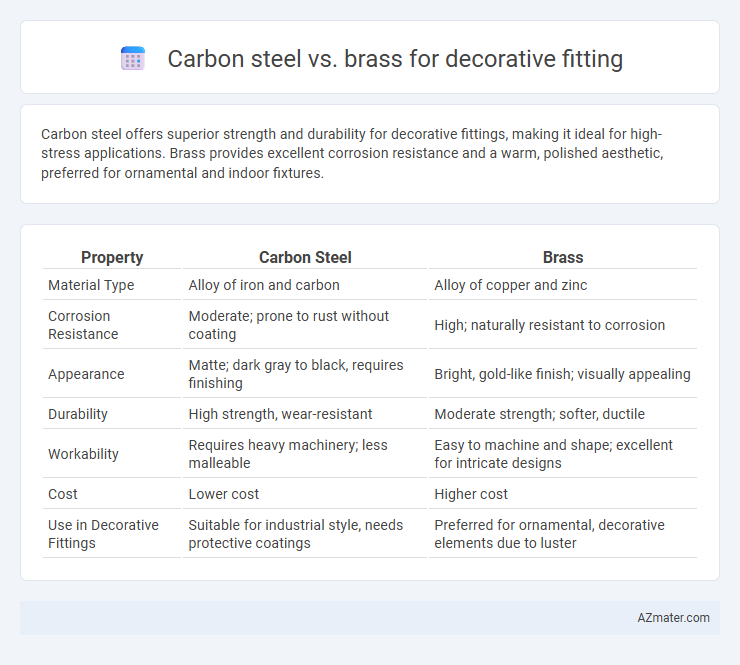Carbon steel offers superior strength and durability for decorative fittings, making it ideal for high-stress applications. Brass provides excellent corrosion resistance and a warm, polished aesthetic, preferred for ornamental and indoor fixtures.
Table of Comparison
| Property | Carbon Steel | Brass |
|---|---|---|
| Material Type | Alloy of iron and carbon | Alloy of copper and zinc |
| Corrosion Resistance | Moderate; prone to rust without coating | High; naturally resistant to corrosion |
| Appearance | Matte; dark gray to black, requires finishing | Bright, gold-like finish; visually appealing |
| Durability | High strength, wear-resistant | Moderate strength; softer, ductile |
| Workability | Requires heavy machinery; less malleable | Easy to machine and shape; excellent for intricate designs |
| Cost | Lower cost | Higher cost |
| Use in Decorative Fittings | Suitable for industrial style, needs protective coatings | Preferred for ornamental, decorative elements due to luster |
Introduction to Decorative Fittings
Decorative fittings fabricated from carbon steel provide exceptional durability and corrosion resistance, making them ideal for structural and ornamental applications requiring long-lasting strength. Brass fittings offer superior aesthetic appeal with their natural gold-like finish and excellent malleability, allowing for intricate designs and smooth surfaces commonly used in high-end interior decor. The choice between carbon steel and brass depends on balancing functional requirements such as strength and resistance with visual elegance and ease of customization in decorative fittings.
Overview of Carbon Steel
Carbon steel offers exceptional strength and durability, making it a preferred choice for decorative fittings that require long-lasting structural integrity. Its high tensile strength resists deformation under stress, while its ability to be easily welded and machined allows for intricate and precise designs. Carbon steel's affordability compared to brass further enhances its appeal for decorative applications demanding both robustness and cost-effectiveness.
Overview of Brass
Brass is an alloy primarily composed of copper and zinc, known for its excellent corrosion resistance and attractive golden appearance, making it ideal for decorative fittings. Its malleability allows intricate designs and detailed craftsmanship, frequently used in interior hardware such as door handles, light fixtures, and ornamental accents. The natural antimicrobial properties of brass also enhance its suitability in decorative applications where hygiene is a concern.
Aesthetic Appeal: Carbon Steel vs Brass
Brass fittings exhibit a warm, golden hue that enhances decorative appeal with a classic and luxurious look, making them ideal for traditional or vintage styles. Carbon steel fittings offer a sleek, industrial aesthetic with a darker, matte finish that complements modern and minimalist designs. Brass maintains its shine and resists tarnishing better than carbon steel, which may require coatings to prevent rust and retain its visual appeal over time.
Durability and Longevity
Carbon steel offers superior durability and longevity for decorative fittings due to its high tensile strength and resistance to wear and impact. Brass, while providing excellent corrosion resistance and an attractive finish, tends to be softer and more prone to surface scratches and dents over time. The choice between carbon steel and brass depends on the balance needed between mechanical strength and aesthetic appeal in long-term applications.
Corrosion Resistance Comparison
Carbon steel offers moderate corrosion resistance but typically requires protective coatings such as paint or galvanization to withstand moisture and environmental exposure in decorative fittings. Brass exhibits excellent corrosion resistance due to its copper and zinc composition, making it highly suitable for decorative applications exposed to humidity or outdoor conditions without additional treatment. Choosing brass over carbon steel reduces the risk of rust and tarnish, ensuring longer-lasting aesthetic appeal in decorative fittings.
Maintenance Requirements
Carbon steel decorative fittings require regular anti-corrosion treatments and periodic repainting to prevent rust and maintain appearance. Brass fittings offer superior corrosion resistance with minimal maintenance, often only needing occasional cleaning to preserve their natural shine. The longevity and upkeep costs of brass fittings are generally lower compared to carbon steel in indoor and outdoor decorative applications.
Cost Analysis
Carbon steel fittings generally offer a lower upfront cost compared to brass, making them a budget-friendly option for large-scale decorative projects. Brass fittings, although more expensive, provide superior corrosion resistance and an aesthetically pleasing finish, which can reduce long-term maintenance and replacement costs. Evaluating total cost of ownership, including durability and upkeep, is crucial for selecting the most cost-effective material for decorative fittings.
Environmental Impact
Carbon steel decorative fittings have a higher environmental impact due to significant energy consumption and carbon emissions during production, yet they are recyclable and durable, reducing long-term waste. Brass fittings, composed of copper and zinc, require more intensive mining and refining processes, contributing to habitat disruption and higher toxic emissions. Choosing fittings with recycled content and considering lifecycle assessments can mitigate environmental harm for both materials.
Best Applications for Carbon Steel and Brass
Carbon steel offers superior strength and durability, making it ideal for decorative fittings subjected to heavy use or outdoor environments requiring resistance to impact and wear. Brass provides excellent corrosion resistance and a visually appealing, warm golden finish, making it the preferred choice for decorative fittings in indoor settings, such as door handles, lighting fixtures, and ornamental hardware. Both materials suit different applications based on environmental exposure and aesthetic demands, with carbon steel favored for structural integrity and brass chosen for decorative elegance and corrosion resistance.

Infographic: Carbon steel vs Brass for Decorative fitting
 azmater.com
azmater.com